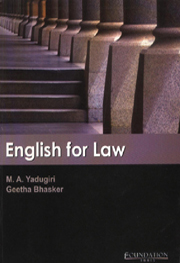Book contents
- Frontmatter
- Preface
- Contents
- A Note to the Student
- Notes to the Teacher
- 1 Nature of Law
- 2 Crimes and Civil Wrongs
- 3 Command of Language in the Profession of the Law
- 4 Plain Language and the Law
- 5 The Indian Constitution
- 6 The Impact of Technology on the Practice of Law
- 7 The International Court of Justice
- 8 Application of Precedents
- 9 Statutory Interpretation
- 10 Legal Reasoning
- 11 Plaints and Writs
- 12 Judgment
- 13 Of Defamation
- 14 Consumer Protection (Amendment) Act, 1993
- 15 The Information Technology Act, 2000
- 16 Universal Declaration of Human Rights
- Answer Key
7 - The International Court of Justice
Published online by Cambridge University Press: 26 October 2011
- Frontmatter
- Preface
- Contents
- A Note to the Student
- Notes to the Teacher
- 1 Nature of Law
- 2 Crimes and Civil Wrongs
- 3 Command of Language in the Profession of the Law
- 4 Plain Language and the Law
- 5 The Indian Constitution
- 6 The Impact of Technology on the Practice of Law
- 7 The International Court of Justice
- 8 Application of Precedents
- 9 Statutory Interpretation
- 10 Legal Reasoning
- 11 Plaints and Writs
- 12 Judgment
- 13 Of Defamation
- 14 Consumer Protection (Amendment) Act, 1993
- 15 The Information Technology Act, 2000
- 16 Universal Declaration of Human Rights
- Answer Key
Summary
Also known as the World Court, the International Court of Justice (ICJ) is based in the Peace Palace, The Hague, Netherlands (Holland). The ‘judicial arm’ of the United Nations (UN), it was created as part of the UN in 1945, replacing its predecessor, the Permanent Court of International Justice.
Procedure
The ICJ is comprised of fifteen judges elected for nine-year terms by the UN's Security Council. Elections are such that five judges are elected every three years. The judges are paid $145,000 every year in salary and in US dollars. The Chief Justice (presently an Algerian, M. Bedaoui) gets a $15,000 bonus. The judges are not elected based on their nationality, but on their knowledge of international law and on a desire that the bench represents ‘the main forms of civilisation and the principal legal systems of the world’. An informal understanding exists whereby members of the Security Council each have a judge on the Court so the unofficial distribution is: Western Europe: 5, North America: 2, Eastern Europe: 2, Africa and the Middle East: 4, Asia: 2 and Latin America: 2. No two judges of the ICJ may be from the same country. A President and a Vice President are selected from the bench by a vote amongst the judges, and for a three year term. Once elected, only a unanimous vote of the other judges can remove an ICJ Justice from office. The ICJ also has the freedom to appoint its own registrar, clerks and other officers. The Court has prepared practice rules.
- Type
- Chapter
- Information
- English for Law , pp. 220 - 244Publisher: Foundation BooksPrint publication year: 2005

